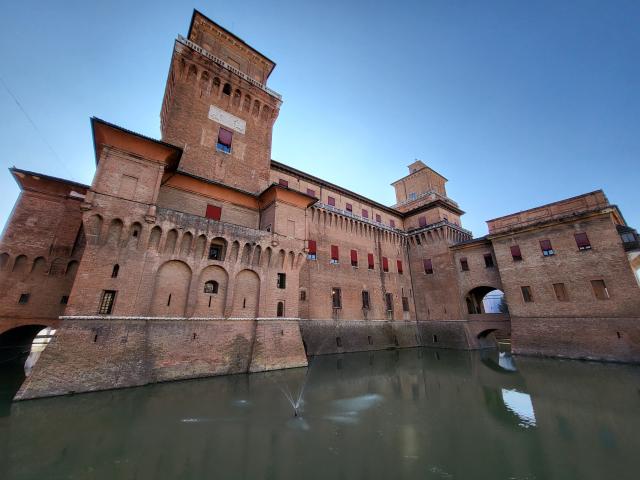Estense Castle

Residence of Lucrezia Borgia and Alfonso d’Este and vital center of the Ferrara court.
The Estense castle is an imposing building ordered to be built in 1385 by Nicolo II to defend the Este family from popular insurrections, linked to the Ducal Palace through a raised passageway, which took the name of Via Coperta, which is still preserved.
The typical structure of a medieval fortress, its marble balconies and its terraces evoke the function of a ducal residence that it had in the 16th century.
It is from that moment on that the castle undergoes various modifications to adapt an old military structure to a residential building, with wide spaces inside and viewpoints in the towers and the addition of a new floor. This aspect is what has been preserved to this day, converted into a hallmark of the population.
The tour of the ground floor leads us to the old kitchens, to the cells, in the basements of the Torre de los Leones, where Ugo and Parisina, stepson and stepmother, protagonists of a forbidden love story, were locked up, and the prison of don Giulio d’Este, imprisoned for a love rivalry and for conspiring.
A long ramp, formerly intended for the artillery, leads to the main floor where the orange garden is located, an entertainment terrace for the court, and the main rooms, decorated with frescoes, among which the Ducal Chapel, the Chamber and the Games Room, the Government Room and the Shields Room, all from times after Lucrezia's death.
In the tower of the Lions you can see a wide view of the entire city, from which you can see the famous extension of the urban area, the Addizione Erculea, begun at the end of the 15th century.
The Estense castle was the place of residence of Lucrezia Borgia and Alfonso d’Este. The newlyweds settled in Castel Vecchio, while Duke Ercole maintained his residence in the Ducal Palace, the current Municipal Palace.
In this complex, the rich palatial life that surrounded Lucrezia as Duchess of Ferrara was ostentatiously manifested. A wide range of gold and silver pieces, Flanders tapestries, silks and precious stones that covered all kinds of garments and objects.





